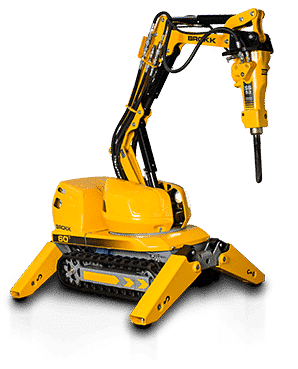Whether you’re a construction company owner or project manager, construction employees are your most-prized assets, vital for the success of any construction endeavor.
Faced with persistent skilled labor shortages, owners and managers must find ways to efficiently manage, motivate, retain, and support the professional development of their construction employees.
So, how can one manage different employees in construction, ranging from architects and engineers to entry-level construction workers, to ensure successful project completion in a positive work environment?
Here are five ways.
In this article...
Set Clear Role Expectations
Your construction employees will do their best work without unnecessary stress when they know what’s expected of them.
This requires skillful planning and organization combined with continuous communication with your employees. However, when done right, little further management is needed.
We’ll start with a recent Gallup study where nearly half of all surveyed employees said they don’t fully understand what’s expected of them at work.
If we transpose this to the construction workforce, it can be said that poorly communicated expectations are a likely culprit behind many delays and cost overruns experienced by most construction projects.
More to the point, look at the list of our tips on increasing your field employee productivity and ask yourself: how many of them involve clear communication (and comprehension) of different expectations?

The first four tips are focused on efficiently monitoring operations, addressing ongoing issues, and relaying general and specific expectations regarding the solutions.
Employee training and worksite inspections are also expectations-based, and even celebrating achievements can be used to set future expectations.
Given how important clear expectations are for the smooth progression of construction operations, you and other management staff should ensure that workers understand why they’re performing certain tasks and what their specific role is.
This will provide clarity, give them a sense of purpose, and improve their job performance with less hands-on management required in the process.
A RACI matrix is one of the best methods to set clear role expectations.
This chart allows you to determine who’s responsible for performing specific tasks (R), who’s accountable for checking their results (A), who should be consulted during task performance (C), and who must be kept informed (I), like in this example, courtesy of Tactical Project Manager:
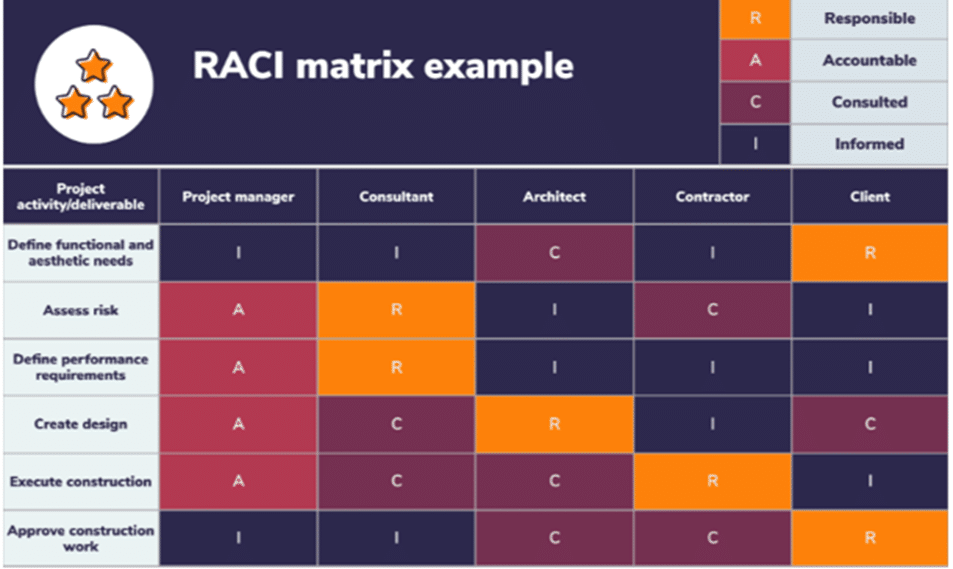
For example, the architect is responsible for creating the design in consultation with the client and the consultants (e.g., engineers, internal designers, zoning officials), while the project manager is accountable for verifying the design in terms of its constructability and other parameters, all of which the contractor is informed about.
When applied correctly, this method clearly defines role expectations, eliminates potential role confusion, enables a balanced allocation of human resources, reduces unnecessary communication threads, and ensures new people can quickly understand what’s expected of them.
The definition and allocation of roles and duties requires some prudent planning and organization, but it alleviates many management headaches down the road.
So, clear expectations and straightforward communication will give your employees clarity and purpose, empower them, improve their performance, and ultimately lead to better productivity.
Train Them Well
Basically, if you have well-trained construction employees who are willing and encouraged to learn new skills and grow through external and internal education and training, as well as through the careful matching of skills and job roles, combined with effective delegation, they won’t need to be managed.
You’d still have to provide feedback and follow-up, though.
For starters, encouraging your employees to become more skilled or qualified and investing in their growth by providing external and internal education and training opportunities will pay off.
You will find yourself retaining, managing, and promoting more competent, motivated, and satisfied workers.
For example, as safety is a high priority in construction, you could entice your team leaders, site managers, or senior crew members to enroll in construction safety training programs aimed at creating a safer work environment and obtain certification in one or more specialized areas offered by the Occupational Safety and Health Administration (OSHA):
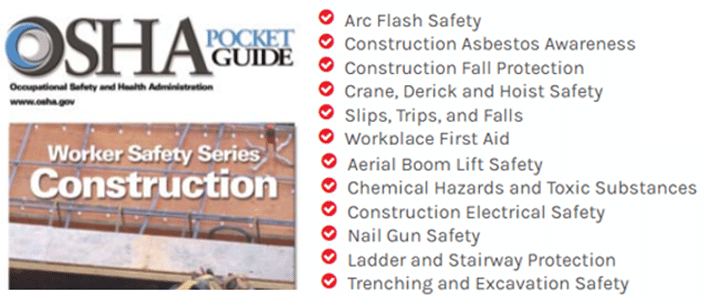
Courses like these enable employees to focus on specific topics where they lack relevant experience or knowledge of safety protocols and procedures.
This enhances their on-the-job performance, as well as that of others, facilitating internal knowledge transfer and improving overall worksite safety.
Moreover, such employees become more competent at their job, which builds their confidence, makes them better team members, and strengthens their commitment to the job.
Their loyalty to their employer also increases.
On top of investing in different types of workforce training and education, companies can do more to help their employees grow professionally.
For instance, at Juneau Construction, they have an internal development and mentorship program that allows their employees to clearly understand what they should do to advance their careers and provides support from internal mentors and project teams.

Finally, as a leader or manager, you can also take certain steps to ensure your employees are constantly moving forward, both professionally and personally.
You can start by carefully matching their skills, experience, and personality traits with job role requirements, followed by an efficient delegation of tasks, constructive feedback, and follow-up without micromanaging.
All in all, train your construction employees well, and they won’t need to be managed (as much).
Use Collaboration Tools
As successful completion of construction projects is predicated upon good communication and collaboration between many stakeholders, including you and your employees, effective management requires the use of efficient collaboration tools.
In today’s world, this primarily refers to different construction management software solutions and technologies.
Such solutions can help you streamline collaboration and communication between all project stakeholders, monitor the tasks and productivity of your construction workforce (including subcontractors), and manage all these moving parts more efficiently.
Nowadays, you can’t efficiently manage growingly complex construction projects and your increasingly complex and diverse workforce without using one or more construction management tools.
For instance, you might opt for an all-in-one software solution that will streamline all construction management processes, such as Contractor Foreman, which, among its many features, allows you to schedule and manage your employees and easily communicate with them.
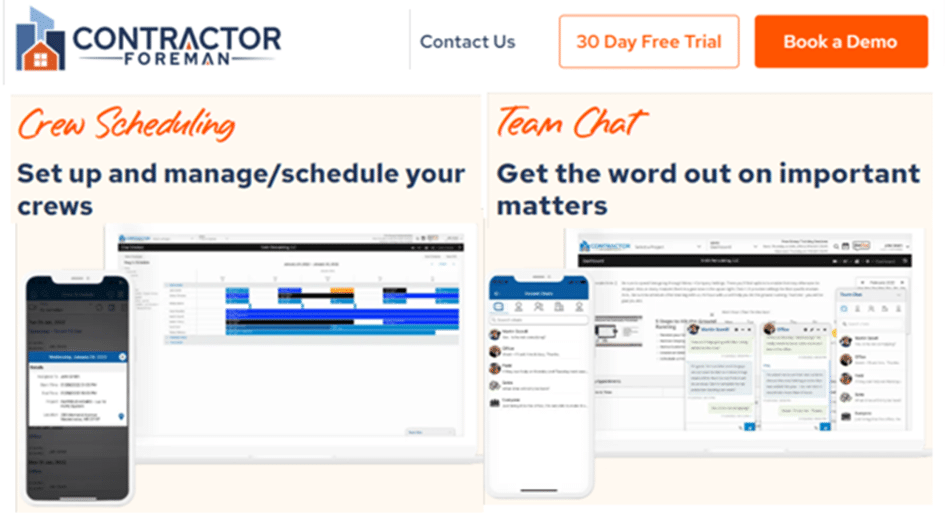
Of course, this and other kinds of software have many other features that make a contractor’s or project manager’s job easier, from planning, budgeting, and scheduling construction projects to managing daily site operations, work orders, and inevitable project changes, to name a few.
One way of keeping collaboration effective is to provide your employees with updates based on real-time (or near-real-time) information on, for example, change orders, rescheduling, equipment servicing dates, etc.
This valuable data is collected by tracking different construction resources (equipment, materials, and labor) and using the insights gained to improve individual and collective decision-making and problem-solving and efficiently deal with various challenges inherent to construction projects.
An asset tracking system like GoCodes provides up-to-date information on the location, usage, and maintenance of tools, equipment, and machinery moving between multiple sites and crews.
This information can then be used to streamline day-to-day operations through collaboration and communication based on the most recent information on different construction project workflows.
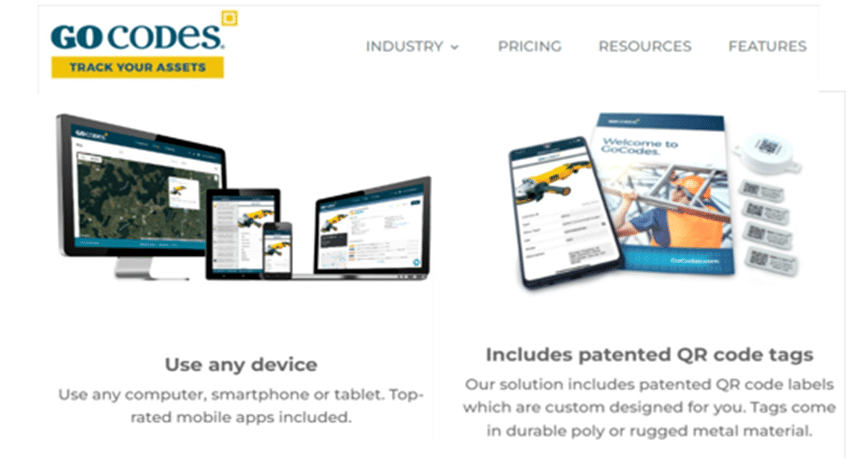
Thus, using collaboration tools that streamline team communication facilitates the management of your construction workforce.
Using them in conjunction with other tools that provide up-to-date information on the utilization of different construction resources allows you to manage, communicate and collaborate on addressing various construction challenges more efficiently.
Address Underperformance
Considering the complex and transient nature of construction projects, you can’t afford to ignore poor performance, as it can adversely affect all aspects of managing a construction company or project.
Thus, you should address employee underperformance directly and timely, explain where their performance is lacking and how they can improve, set the timeframe for improvement, and be clear about the consequences of failing to do so.
We already stressed how important good communication, regular feedback, and follow-up are for efficiently managing your construction employees—if expectations are continuously made clear, workers are well-trained, and strong collaboration tools are in place, performance issues should be significantly minimized.
This is of paramount importance for the success of your construction endeavor.
For example, consider the challenges that project managers face above and beyond managing their construction employees:
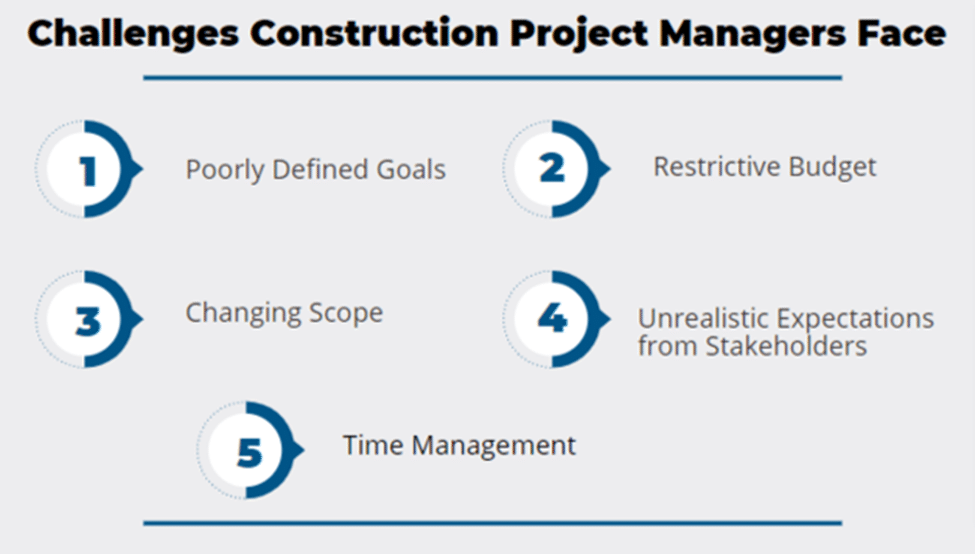
Having to deal with these and many other issues, risks, and constraints inherent to construction projects means that poor job performance can also stem from numerous other factors, which should be considered when tackling it.
However, when faced with underperformance, you should immediately address it to prevent it from becoming a norm (for that employee and other workers).
First, try to understand the reasons behind someone’s poor job performance. Are they unsure of what’s expected of them?
Are their skills not matching the task? Or are they experiencing stress at work or home?
Next, set up a one-on-one meeting with the underperforming employee. Giving this type of feedback is best handled one-on-one.
Otherwise, you’re risking shaming them in front of their colleagues, further lowering their confidence and motivation, not to mention the effect that can have on other employees.

So, in a private setting, you should calmly but clearly, explain where their performance is falling short and support it with specific examples of their past actions.
Where you go from there largely depends on the employee’s reaction to your feedback—if they accept responsibility, they’re ready to hear how they can improve.
However, if they’re blaming, for example, external circumstances (like project changes) or other team members, the improvement plan should be preceded by clearly stating what the consequences of failing to improve will be (demotion, termination).
Now it’s time to provide step-by-step directions on how they can improve their performance and align it with job role expectations.
This should include examples and a clear roadmap of how to get there, along with the agreed timeframe and progress follow-up.
In conclusion, directly and promptly addressing underperformance by outlining the improvement plan and timeline, combined with active listening and good people skills, will ultimately give you more time to focus on other construction project challenges.
Award Good Work
If you sometimes have to use a metaphorical stick to address underperformance and more efficiently manage your construction employees, you should also use different “carrots” to acknowledge and award their good work.
Methods to do that range from construction companies offering great pay, benefits, and career development packages to managers giving small rewards and celebrating successes.
Of course, offering competitive pay is an effective way to attract, manage and retain your construction employees.
However, employees want to have good benefits and career development opportunities too.
Moreover, recent studies have shown that work-life balance is often more important than salary. For instance, the one where 65% of respondents stated they strongly agree with that statement.
That’s where different types of benefits come in.
Again, we’ll use Juneau Construction Company as an example. The list of benefits they provide is multifaceted and adaptable to the changing needs of employees.
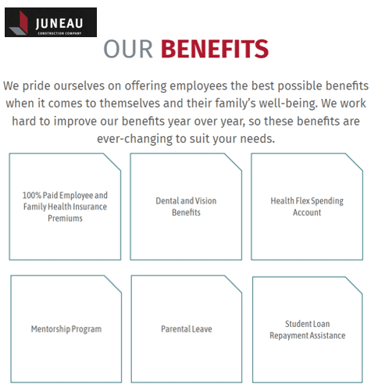
This is a great example of what can be done to award good work at the company level.
As the leader or manager, you can also employ different tactics to let your employees know their work is appreciated, their contributions valued, and their voices heard.
These will create a positive work environment, which could be considered the best award for good work because it improves everything, from team communication and collaboration to overall employee performance and productivity.
For example, if you were a construction site manager, you could take your construction crew to lunch to show them you value their hard work.
Or you could give everybody an extra hour off on Friday.
On top of that, you can use different opportunities to celebrate successes, such as completing a project on time and within budget.
Whatever methods you choose, make sure you’re honest and will stand behind your word, especially when using promises of future rewards to motivate your employees.
So, from great pay, benefits, and work-life balance to small prizes and celebrated successes, there’s plenty you can do to acknowledge and award the good work of your construction employees.
Conclusion
As we’ve reached the end, just a reminder that employees are your most-prized assets, especially in light of skilled labor shortages.
As such, they should be managed with care, which includes setting clear role expectations, investing in their training, providing learning and development opportunities, using different collaboration tools, dealing with underperformance, and awarding their good work.
The result?
Competent, satisfied, and motivated construction employees efficiently managed by a great leader.
This article is a brief overview of five ways to manage different construction employees to ensure successful project completion. how to manage construction workers




